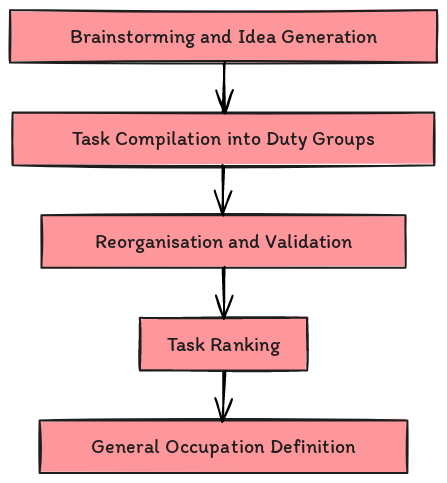Technical and Vocational Education and Training (TVET) prepares individuals for specific trades, careers, and occupations at various levels. For TVET programmes to be effective, the curriculum must be carefully developed to ensure it meets the demands of the workforce. One of the most effective methods for developing such curricula is the DACUM (Developing a Curriculum) model. Invented at Ohio State University in 1976, DACUM is an evidence-based approach that uses focus groups and storyboarding to create detailed job maps, which serve as the foundation for curriculum development. This article explores the DACUM model’s application in TVET, detailing its processes, benefits, and implementation strategies.
Understanding the DACUM Model
The Concept of DACUM
DACUM is a participatory and systematic process that involves current workers in a specific job role to identify and articulate the tasks and duties associated with that role. This grassroots approach ensures that the curriculum is both relevant and comprehensive. The DACUM process involves several key steps:

- Brainstorming and Idea Generation: This initial step involves assembling a group of high-performing employees and pairing them with a facilitator and a recorder. The employees brainstorm all the tasks they perform in their roles, each task beginning with an action verb for clarity and consistency.
- Task Compilation into Duty Groups: Once a comprehensive list of tasks is generated, these tasks are grouped into broader categories of duties. Each job typically encompasses six to twelve duties, comprising at least four tasks.
- Reorganisation and Validation: The task lists are refined and validated, ensuring each task is clearly defined and placed under the correct duty. This step involves rigorous scrutiny to ensure all relevant tasks are captured and accurately described.
- Task Ranking: Tasks are then ranked based on their importance and frequency. This ranking uses four categories: Essential, Tedious, Introductory, and Reiteration. This helps prioritise training efforts and ensures critical tasks receive the most focus.
- General Occupation Definition: The final step is to create a general occupation definition. This concise summary includes the job title, primary tasks, methods used, and the purpose of the role.
The DACUM Process in Detail
Step One: Brainstorming and Idea Generation
The brainstorming phase is essential as it taps into the tacit knowledge of experienced employees. These employees, considered subject matter experts, provide insights that external observers might overlook. The facilitator guides the session to ensure all relevant tasks are captured without bias. Tasks are written on sticky notes, making it easy to rearrange and categorise them later. For example, tasks such as “prepare daily work schedules,” “conduct safety inspections,” and “maintain equipment” would be listed.
Step Two: Compile Your Tasks into Groups of Duties
After brainstorming, the next step is to group the tasks into cohesive duty areas. This organisation helps create a structured curriculum that mirrors the actual workflow of the job. Duties are broader categories under which specific tasks fall. For instance, a duty might be “Equipment Maintenance,” under which tasks like “lubricate machinery,” “replace worn-out parts,” and “perform diagnostic tests” are grouped.
Step Three: Reorganise and Validate
This step involves refining the task and duty lists to ensure completeness and accuracy. The goal is to transform rough ideas into detailed, actionable steps. Each task must include an action verb and an object, such as “prepare trays for the next shift.” This step also involves cross-referencing tasks to ensure no critical activities are missed, and the workflow is logical and comprehensive.
Step Four: Rank Each Task
Ranking tasks help in prioritising training efforts. Tasks are categorised into:
- Essential: Critical for job performance and must be mastered early.
- Tedious: Time-consuming tasks that, while important, do not require immediate mastery.
- Introductory: Tasks suitable for new hires during their initial training.
- Reiteration: Tasks that need regular review and practice to maintain proficiency.
This categorisation helps design a phased training programme that introduces new hires to the most critical tasks first while ensuring ongoing employee training.
Step Five: Define the General Occupation Definition
The general occupation definition encapsulates the essence of the job role. It includes:
- Who: The job title or role.
- What: The primary tasks performed.
- How: The methods and techniques used.
- Why: The purpose and significance of the role.
For example, a definition for a “Maintenance Technician” might be: “A maintenance technician (WHO) ensures the efficient operation of machinery and equipment (WHAT) by performing routine inspections, troubleshooting issues, and conducting repairs (HOW) to minimise downtime and enhance productivity (WHY).”
Strengths of DACUM in TVET
Competency-Based Training (CBT)
The DACUM model aligns perfectly with competency-based training (CBT) principles and a flexible and learner-centred approach. CBT focuses on the competencies required to perform a job, making it highly relevant for TVET. DACUM supports CBT by:
- Defining Clear Competencies: Each task and duty is measurable, ensuring learners understand precisely what is expected.
- Efficiency: The DACUM process can achieve comprehensive results in a few days, significantly faster than traditional methods.
- Modularity and Customisation: The tasks and duties identified can be modularised, allowing training programmes to be customised to meet specific needs.
- Prior Learning Assessment: DACUM facilitates recognising prior learning, enabling learners to receive credit for existing skills and knowledge.
- Performance-Based Evaluation: The DACUM model includes a proficiency rating scale that can be used to assess learners’ performance throughout their careers.
Synergies Between Employers and Training Providers
DACUM promotes collaboration between employers and training providers, ensuring that training programmes are aligned with industry needs. This collaboration is essential for the development and delivery of effective CBT programmes. Employers provide insights into the skills and knowledge required for specific roles, while training providers design and deliver the curriculum based on these insights.
Implementing DACUM in TVET
Collaboration with Industry Experts
A successful DACUM process requires the active involvement of industry experts. These experts bring practical experience and knowledge that are invaluable in defining job tasks and duties. Training providers must create an environment that encourages and facilitates this collaboration. This includes:
- Identifying Training Needs: Industry experts help identify the skills and knowledge that are most in demand.
- Defining Learning Outcomes: Experts work with training providers to define measurable learning outcomes.
- Co-Creating Learning Activities: Industry experts contribute to the design of learning activities that reflect real-world tasks and challenges.
Supporting Instructors
Transitioning from a teacher-centred to a learner-centred approach is essential for the success of DACUM in CBT. Instructors need support and training to make this transition. This includes:
- Professional Development: Providing instructors with training on the principles and practices of CBT and the DACUM process.
- Resource Allocation: Ensuring instructors have the resources to implement the DACUM-based curriculum effectively.
- Ongoing Support: Offering continuous support and feedback to instructors as they adapt to the new approach.
Conclusion
The DACUM model is a powerful tool for developing curricula in TVET, ensuring that training programmes are aligned with industry needs and grounded in real-world tasks. By involving current employees in the curriculum development process, DACUM ensures that the training is relevant, comprehensive, and effective. The model’s strengths, particularly in supporting competency-based training, make it an ideal choice for TVET programmes. By promoting collaboration between employers and training providers and supporting instructors in adopting a learner-centred approach, DACUM can help create training programmes that enhance job readiness and performance, ultimately contributing to a more skilled and satisfied workforce.



